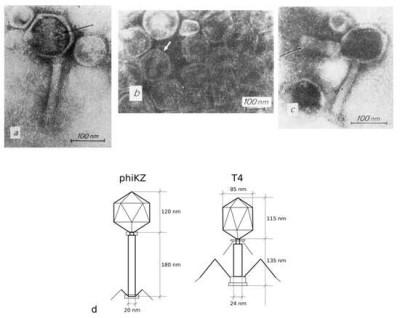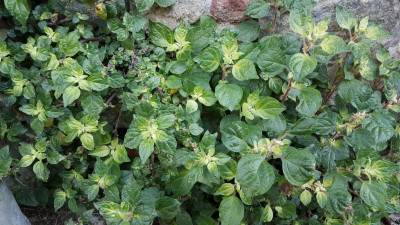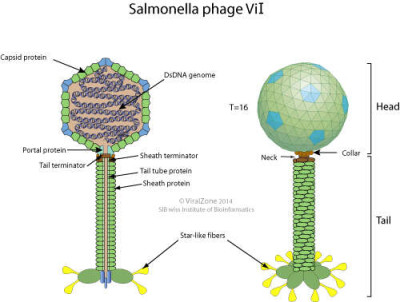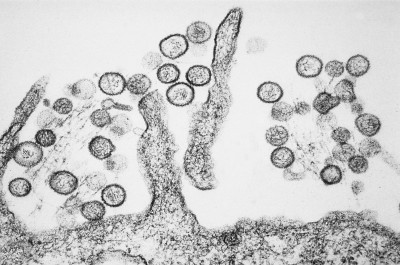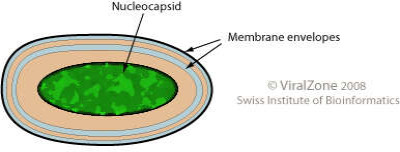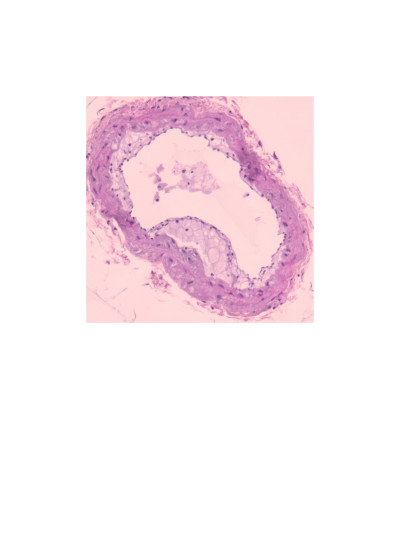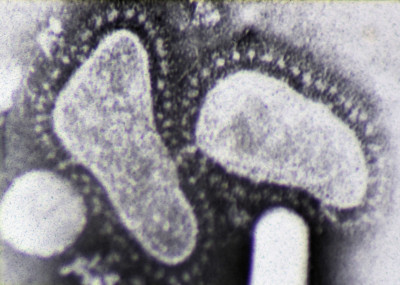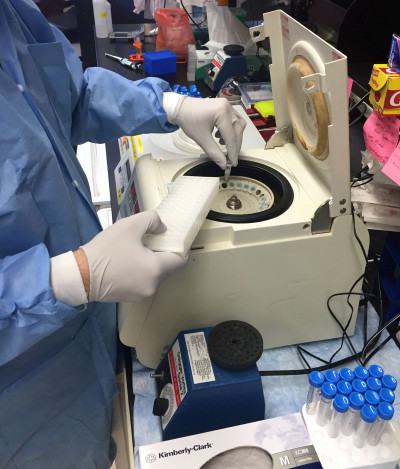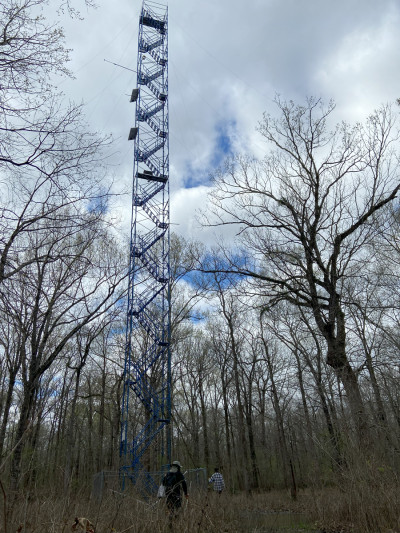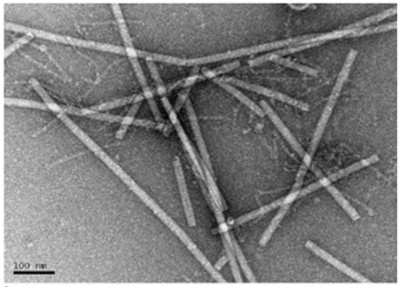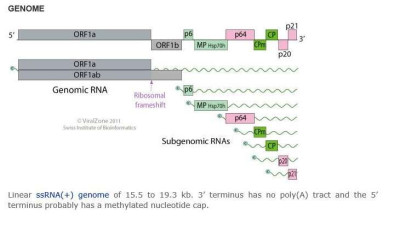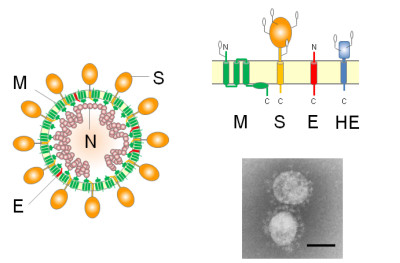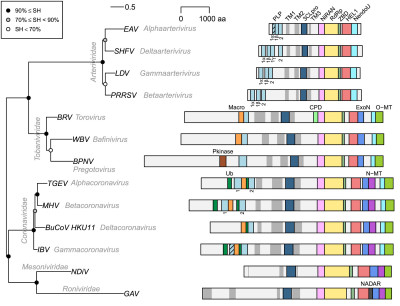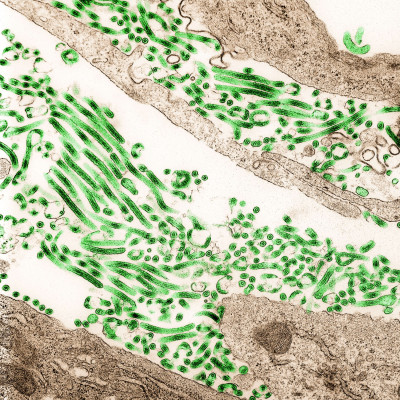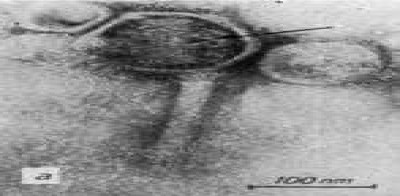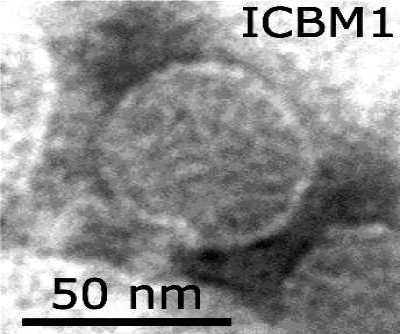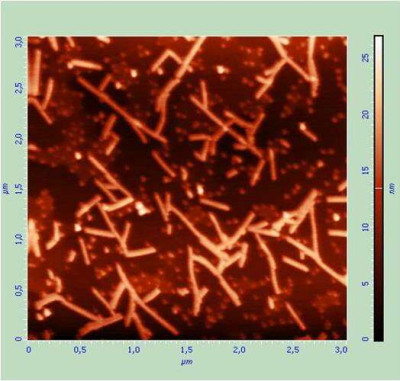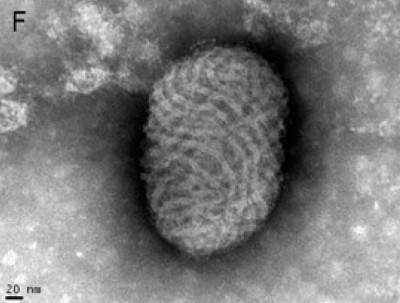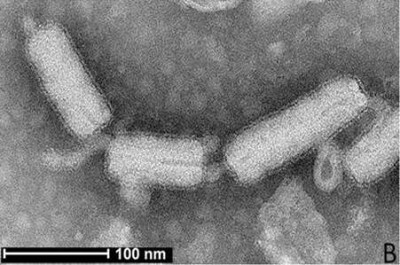Ultrastructure of phiKZ phage particles after a freezing and thawing procedure: (a) Phage particle with a disrupted head. The arrow indicates the inner cylindrical body with loops of fibrous material (perhaps DNA) around; (b) The head of a tail-less phiKZ particle with an inner body (the arrow indicates the inner cylindrical body); (c) The inner body coming out of the phiKZ particle disrupted by freezing and thawing (arrow) [23]; (d) A schematic drawing of phage phiKZ and T4-particles for size comparison.
Wikimedia Commons, Victor Krylov, Maria Bourkaltseva, Elena Pleteneva, Olga Shaburova, Sergey Krylov, Alexander Karaulov, Sergey Zhavoronok, Oxana Svitich, Vitaly Zverev
18 Apr 2024
Parietaria mottle virus (PMoV) is a plant virus that infects members of the Parietaria genus, particularly Parietaria judaica, commonly known as pellitory-of-the-wall or wall pellitory. This virus belongs to the family Tombusviridae and is known to cause mottling symptoms on the leaves of infected plants. Infected plants typically exhibit symptoms such as mottling or discoloration of the leaves, which appear as irregular patches of light and dark green. In addition to mottling, infected plants may also show stunting, leaf distortion, and reduced vigor, although symptoms can vary depending on factors such as the strain of the virus and environmental conditions.
iNaturalist
11 May 2024
Non-enveloped, rod of filaments of 7nm in diameter and 700 to 2000nm in length. Helical capsid with adsorption proteins on one end.
ViralZone, SIB Swiss Institute of Bioinformatics
25 Jan 2024
Schematic drawing of a virion of the species Salmonella virus ViI.
ViralZone, SIB Swiss Institute of Bioinformatics
31 Jan 2024
Transmission electron micrograph of the Sin Nombre Hantavirus. Hantaviruses that cause Hantavirus pulmonary syndrome (HPS) are carried in rodent droppings, especially the deer mouse. Incubation lasts for 1–5 weeks. Sickness begins with fever and muscle aches, followed by shortness of breath and coughing.
Public Health Image Library (PHIL), Wikimedia Commons
23 Feb 2024
Schematic drawing of a virion of the genus Ichnovirus (cross section). Enveloped, prolate ellipsoid form (ichnoviriform) and cylindrical (bracoviriform). Depending on the species, a virion contains one or several nucleocapsids.
ViralZone, SIB Swiss Institute of Bioinformatics, Wikimedia Commons
23 Feb 2024
Electron micrograph of two coronaviruses.
Graham Beards, Wikimedia Commons
01 Mar 2024
A Zika virus researcher at the NIAID Vaccine Research Center loads samples into a microcentrifuge.
Wikimedia Commons, NIAID
01 Mar 2024
The picture shows on duty US-ULM carbon flux tower that measures molecular level carbon and water exchange between the Bottomland Hardwood Forest and the atmosphere at Russel Sage Wildlife Management Area in Northeast Louisiana.
11 Mar 2024
Electron micrograph illustration of viral particles. [1]
Luria N, Smith E, Reingold V, Bekelman I, Lapidot M, Levin I, et al., Wikimedia Commons
14 Mar 2024
The virion RNA is infectious and serves as both the genome and viral messenger RNA. ORF1a and ORF1ab protein (containing RdRp) are produced by ribosomal frameshifting. Other ORFs are translated from a set of nested 3' co-terminal subgenomic RNAs.
ViralZone, Swiss Institute of Bioinformatics
01 Apr 2024
(left) Schematic diagrams of coronavirus virions; (right top) The topology of the four structural envelope proteins. All proteins are depicted as monomers, but the S and HE proteins form homotrimers and homodimers, respectively. Oligosaccharides are shown on the M, S, and HE proteins. Although a number are omitted, the S and HE proteins contain 21 to 35 and 9 (BCoV HE) potential N-glycosylation sites, respectively; (right bottom) Electron micrograph of SCoV. Bar: 100 nm. (EM image courtesy of Dr. Nagata at National Institute of Infectious Diseases).
Wikimedia Commons, Makoto Ujike and Fumihiro Taguchi
02 Apr 2024
Phylogeny and pp1ab domain organization of selected nidoviruses. Representatives of 13 lineages of nidoviruses that infect vertebrates (three virus families) and invertebrates (two virus families) are depicted. Names of taxa, families and genera, are indicated in grey italic font, and names of viruses are given as acronyms: EAV, equine arteritis virus; SHFV, simian hemorrhagic fever virus; LDV, lactate dehydrogenase-elevating virus; PRRSV, porcine reproduction respiratory syndrome virus; BRV, Breda virus; WBV, white bream virus; "BPNV, ball python nidovirus;" TGEV, porcine transmissible gastroenteritis virus; MHV, mouse hepatitis virus; BuCoV_HKU11, bulbul coronavirus HKU11; IBV, avian infectious bronchitis virus; NDiV, Nam Dinh virus; GAV, gill-associated virus. Midpoint rooted phylogeny was reconstructed based on Viralis multiple sequence alignment [1] of the conserved core of RdRp, using IQ-Tree 1.5.5 [2] with automatically selected the rtREV + F + I + G4 evolutionary model. To estimate branch support, SH-like approximate likelihood ratio test with 1000 replicates was conducted. Polyproteins pp1ab are shown as light grey bars; they are autoproteolytically processed to nsps that were identified only for few nidoviruses and omitted here. TM domains are shown as dark grey bars; TM helices were predicted by TMHMM2.0c [3] and clustered if separated by less than 300 aa (less than 180 aa for arteri- and tobaniviruses). Other selected domains, whose coordinates were obtained from the Viralis database [1], are shown as colored bars; proteolytically inactive PLP domains are indicated by stripes on bars; indices of PLP domains are specified below the bars. "Pkinase, protein kinase [4]; CPD, cyclic phosphodiestarase known also as 2′,5′-phosphodiesterase, 2′PDE [5][6]; NADAR, domain involved in the utilization of NAD and ADP-ribose derivatives [7].
Wikimedia Commons, Anastasia A. Gulyaeva, Alexander E. Gorbalenya
02 Apr 2024
Colorized transmission electron micrograph of Ebola virus particles (green) found both as extracellular particles and budding particles from chronically-infected African green monkey kidney cells (brown).
Wikimedia Commons, NIAID
02 Apr 2024
Ultrastructure of phiKZ phage particles after a freezing and thawing procedure. Phage particle with a disrupted head. The arrow indicates the inner cylindrical body with loops of fibrous material (perhaps DNA) around.
Wikimedia Commons, Krylov, V., Bourkaltseva, M., Pleteneva, E., Shaburova, O., Krylov, S., Karaulov, A., Zhavoronok, S., Svitich, O., Zverev, V
10 Apr 2024
Transmission electron micrograph of molybdenum stained, cell debris bound Lentibacter virus vB_LenP_ICBM1 (genus Siovirus, fam. Zobellviridae, ord. Caudovirales ).
Wikimedia Commons
10 Apr 2024
Researchers applied ultrahigh-vacuum atomic force microscopy (UHV-AFM) for investigation of tobacco mosaic virus (TMV) and alfalfa mosaic virus (AMV) interaction with Si (1 1 1) surface. Changes of virion conformation and different degree of order on the investigated surface were established. It was demonstrated that adsorption of TMV virions is accompanied with formation of predominantly single-layered ordered films while AMV adsorption is accompanied with formation of unordered accumulations of the virions and more abrupt change of the height of viral particles. It was established that the change of virions’ height depended on the quantity of negatively-charged amino acid residues on the outer surface of capsid.
Wikimedia Commons, Irina Kovalchuk
18 Apr 2024
Transmission electron microscopy (TEM) image of an orf virus (parapoxvirus PPV) after negative staining. [1]
Wikimedia Commons, Oran Erster, Sharon Melamed, Nir Paran, Shay Weiss, Yevgeny Khinich, Boris Gelman, Aharon Solomony, and Orly Laskar-Levy
24 Apr 2024
Negative-stained sap of infected rice leaves Black arrows indicate the RSMV virions with enveloped. [1]
Wikimedia Commons, Xin Yang, Jilei Huang, Chuanhe Liu, Biao Chen, Tong Zhang, and Guohui Zhou
10 May 2024
 Encyclopedia
Encyclopedia
